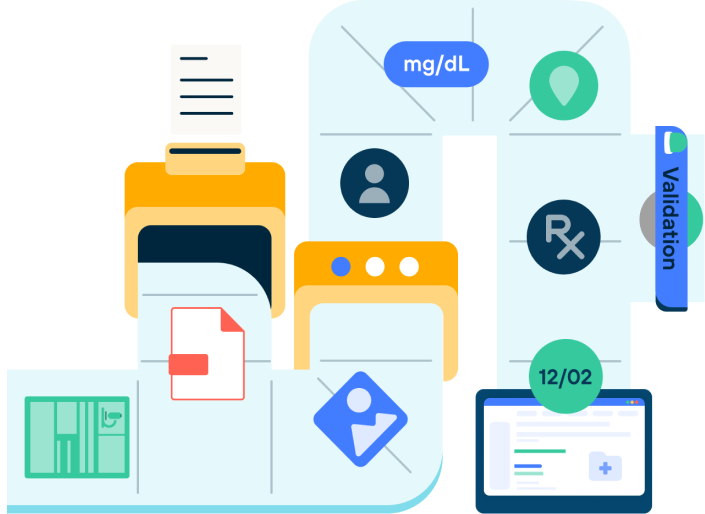Integrate accurate, accessible patient data across your health information ecosystem

Turn millions of medical records
into structured, integrated data with DataBank’s
AI-Powered Document Processing.
Experience the impact AI-Powered Document Processing has on your ability to serve.

Get structured, searchable patient data
Process thousands and millions of historical and current medical records, then automatically find and label key patient data within them based on your set criteria.

Improve patient care plans
Eliminate errors that come with manual indexing and build confidence in your data– the same data that ensures diagnoses and care plans are effectively transmitted from care team to patient.

Trust a single information source across the healthcare network
Your medical records will be consistent across health systems, eliminating repetitive indexing.

Reduce manual indexing labor and associated costs
Decrease the back-office paperwork and data entry your care teams are required to do so they can prioritize their patients and health outcomes.

Boost patient experiences
Patients are more likely to receive the care they need and have higher satisfaction levels when their related notes and documentation are accurate.
Take the first step toward automated medical record indexing.
Common records we process
We’re not limited to these, but here are a few we see every day.
Lab results
Immunization records
Diagnostic records like x-rays, MRIs, and CT scans
Consent forms
Treatment plans
Progress notes
Medical history
Patient demographic information
Discharge summaries
Referral letters
And more
How it works
Here’s how we help you reach your goals with intelligent document processing:
Step 1
Outline objectives and choose your approach
Select from full-service, where we handle all scanning and validation, self-service, or a combination of the two to handle processing.


Step 2
Fix your file intake problem
We’ll convert all existing and incoming paper documents to prepare them for processing at one of our SOC2 Type II and HIPAA-compliant regional facilities.
If you have records already digitized, this step also includes routing those PDFs.
Step 3
Intelligent document processing
Then, we use AI and machine learning on a large scale to identify and label key fields. This technology is already familiar with recognizing essential fields and data points in the healthcare industry, reducing the workload for your teams.


Step 4
Deliver and activate your data
We deliver to any EMR system or can set up data warehousing or enterprise content management.
With all this data in your systems, now you can automate any highly manual process and start implementing business intelligence tools – be an observer of the data in action.
Let’s put you in control of your
healthcare information.
What you can expect
Common problems solved with AI-Powered Document Processing

Speed
Automate data intake with precision to eliminate discrepancies across systems

Visibility
Protect your sensitive patient data while navigating complex regulatory requirements like HIPAA and GDPR

Collaboration
Build trust between care teams and patients with reliable information no matter where it’s viewed

Structure
Promote faster billing cycles with better data control and accuracy
Real results
With AI-Powered Document Processing, a mid-Atlantic Healthcare Network has seen the following results:

Automated indexing
Eliminate manual indexing, saving operational costs and getting care teams time back with their patients

55% cost decrease
The cost to index per document was reduced from $1.50 to $0.68.

$7.9m annual savings
Projected annual savings as a direct result of the adoption of the automated indexing system

210% ROI
Projected return on investment for the implementation organization-wide
Why DataBank?
Technical experts with knowledge of specific medical record and health information management processes

Mature security program includes Managed Endpoint Security, SIEM, Threat Intelligence, HIPAA compliance, and human oversight for robust protection and regulatory adherence

Prioritize sustainable outcomes over band-aid fixes or pushing software products
Flexible service options to work with the resources you’ve got– like full-service processing, self-service, or a combination of the two
Improve your care plans and diagnostic accuracy, starting with how you intake data. Let’s get to work.










